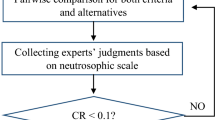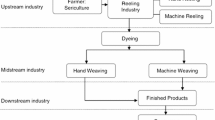Abstract
Purchasing accurate capital equipment to meet the demand of a user in all respect is definitely a strategic decision that involves high initial investment, detailed functional analysis of available alternatives and obtaining the right decision in terms of its productivity, reliability, maintainability and cost. The present study emphasizes upon proper identification and ranking of customer requirements and subsequent technical requirements for four alternative hydraulic cranes taken into consideration. To determine the interrelationship among the customer requirement and technical requirement, the study first employs analytic hierarchy process approach for ranking of customer requirement and checking the consistency of ranking. Next, an analytic hierarchy process–quality function deployment procedure is employed to rank the alternatives based on technical requirement and customer requirement. Further, the cost implications of the equipment are taken into consideration and through a Sensitivity Analysis approach including subjective factor measurement and objective factor measurement, the equipment is ranked. The degree of sensitivity was further verified with a range of values of subjective factor measure for each category of crane. Finally, a zero–one goal programming method is applied to strengthen further the ranking of the equipment applying LINDO platform, where along with the identified technical requirements, agility and reliability are also taken into account. The agility is represented in terms of associated cost implications to meet the technical requirement, whereas the reliability of components is determined by the condition of failure.



*Courtesy: Jaypee Engineering and Hydraulic Equipment Co Pvt Ltd. Kolkata, India (permission obtained)






Similar content being viewed by others
References
E. Hoffman, J. Homstein, D. Maucher, R. den Ouden, Process for the Procurement of Capital Equipment. Capital Equipment Purchasing. Professional Supply Management, vol. 2 (Springer, Berlin, 2012)
M. Leenders, P.F. Johnson, A. Flynn, H. Fearon, Chapter 16. Capital goods. in Purchasing and Supply Management, 13th edn. (The Mcgraw Hill Companies, Boston, 2006)
K.R. Gaurh, I. Khan, M.K. Ghosh, MCDM techniques for the selection of material handling equipment in the automobile industry. Int. J. Mod. Eng. Res. 4(1), 46–52 (2014)
P. Karande, S.Chakraborty, Material handling equipment selection using weighted utility additive theory. J. Ind. Eng., vol. 2013, Article ID 268708, pp. 01–09
A.Y. Chamjini, S. Shariati, Selection of material handling equipment system for surface mines by using a combination of fuzzy MCDM models. Int. Res. J. Appl. Basic Sci. 5, 1501–1511 (2013)
T.E. Saputro, B.D. Rouyendegh, A hybrid approach for selecting material handling equipment in a warehouse. Int. J. Manag. Sci. Eng. Manag. 11(1), 34–48 (2016). https://doi.org/10.1080/17509653.2015.1042535
S. Onut, S.S. Kara, S. Mert, Selecting the suitable material handling equipment in the presence of vagueness. Int. J. Adv. Manuf. Technol. 44(7), 818–828 (2009)
S. Chakraborty, D. Banik, Design of a material handling equipment selection model using analytic hierarchy process. Int. J. Adv. Manuf. Techol. 28(11), 1237–1245 (2006)
A.M. Momani, A.A. Ahmed, Material handling equipment selection using hybrid monte carlo simulation and analytic hierarchy process. World Acad. Sci. Eng. Technol. Int. J. Ind. Manuf. Eng. 5(11), 2177–2182 (2011)
A.V. Khadekar, S. Chakraborty, Selection of material handling equipment using fuzzy axiomatic design principles. Informatica 26(2), 259–282 (2015)
K. Sen, S. Ghosh, B. Sarkar, Study of customer choice for bulk material handling equipment. The MADM approach, in Proceedings of the 30th National Convention of Production Engineers. Agartala (2015)
K. Sen, S. Ghosh, B. Sarkar, Comparison of customer preference for bulk material handling equipment through fuzzy-AHP approach. J. Inst. Eng. (India): Ser. C 98(3), 367–377 (2017)
L. Cohen, Quality Function Deployment: How to make QFD work for you? Engineering Process Improvement Series (Chapter 1) (Pearson Education, Singapore, 2005), pp. 11–22
E.E. Karsak, S. Sozer, S.E. Alptekin, Product planning in quality function deployment using a combined analytic network process and goal programming approach. Comput. Ind. Eng. 44, 171–190 (2002)
F. De Felice, A. Petrillo, A multiple choice decision analysis: an integrated QFD–AHP model for the assessment of customer needs. Int. J. Eng. Sci. Technol. 2(9), 25–38 (2010)
G.H. Mazur, Voice of Customer Analysis: A Modern System of Front End Tools with Case Studies, vol. 51 (Annual Quality Congress, Orlando, 1996)
C.C. Tseng, C.C. Torng, Prioritization determination of project tasks in QFD process using design structure matrix. J. Qual. 18(2), 137–153 (2011)
H. Rahajaro, M. Xie, A.C. Brombacher, A systematic methodology to deal with the dynamics of customer needs in quality function deployment. Expert Syst. Appl. 38(4), 3653–3662 (2011)
Hao-Tien Liu, Chin-Hong Wong, An advanced quality function deployment model using fuzzy analytic network process. Appl. Math. Model. 34(11), 3333–3351 (2010)
J.C. Chen, B.P. Huang, Developing a manufacturing technology curriculum using QFD to incorporate the voice of customer. Int. J. Technol. Eng. Educ. 4, 05–14 (2007)
S.S. Pawar, D.R. Phalke, D.S. Verma, Design optimization with entropy using QFD. Int. J. Recent Sci. Res. 6(5), 4123–4127 (2015)
C. Kahraman, T. Ertay, G. Buyukozkan, A fuzzy optimization model for QFD planning process using ANP approach. Eur. J. Oper. Res. 171(2), 390–411 (2006)
G.H. Mazur, J. Gibson, B. Harries, QFD applications in health care and quality of work life, in First International Symposium on QFD. Tokyo, 01–09 (1995)
M.K. Roy, A. Roy, B.B. Pradhan, Nontraditional machining process selection using integrated AHP and QFD techniques: a customer perspective. Prod. Manuf. Res. 2(1), 530–549 (2014)
K. Prasad, E.K. Zavedskas, S. Chakraborty, A software prototype for material handling equipment selection for construction sites. Autom. Constr. 57, 120–131 (2015)
Chin-Nung Liao, A Zero one goal programming model for marketing project selection. J. China Inst. Technol. 40(06), 77–88 (2009)
B.B. Tripathy, M.P. Biswal, A Zero one goal programming approach for project selection. J. Inf. Optim. Sci. 28(4), 619–626 (2007)
R. Santhanam, K. Muralidhar, M. Schniederjans, A Zero-one goal programming approach for information system project selection. OMEGA Int. J. Manag. Sci. 17(6), 583–593 (1989)
A.J. Keown, B.W. Taylor III, C.P. Duncan, Allocation of research and development funds: a Zero one goal programming approach. OMEGA Int. J. Manag. Sci. 7(4), 345–351 (1979)
R.S. Chen, J.Z. Shyu, Selecting a weapon system using Zero-one goal programming and analytic network process. J. Inf. Optim. Sci. 27(2), 379–399 (2013)
K.G.D. Prasad, K.V. Subbaiah, K.N. Rao, Multiobjective optimization approach for cost management during product design at the conceptual phase. J. Ind. Eng. Int. 10, 01–12 (2014)
J. Kaur, P. Tomar, Multi objective optimization model using preemptive goal programming for software component selection. Int. J. Inf. Technol. Comput. Sci. 09, 31–37 (2015)
B. Yilmaz, M.A. Dagdeviren, Combined approach for equipment selection: F-PROMETHEE method and Zero one goal programming. Expert Syst. Appl. 38(9), 11641–11650 (2011)
S.S. Rao, Engineering Optimization Theory and Practice, vol. 207, 4th edn. (Wiley, New York, 2009)
A. Barve, Impact of supply chains agility on customer satisfaction, in Interantional Conference on E-Business, Management and Economics. IPEDR, vol. 3, IACSIT Press, Hong Kong, pp. 325-329 (2011)
K. Fergis, The Impact of an Agile Methodology on Software Development Costs. University of Pennsylvania, Scholarly Commons, Department of Computer & Information Science. Technical Reports. MS-CIS 12-09 (2012)
R. Imache, S. Izza, M.A. Nacer, An enterprise information system agility assessment model. Comput. Sci. Inf. Syst. 9(1), 107–133 (2012)
D.W. Benbow, H.W. Broome, The Certified Reliability Engineer Handbook, 1st edn. (New Age International (P) Ltd., New Delhi, 2010)
V.R. Dukkipati, K.P. Ray, Product and Process Design for Quality, Economy and Reliability (Chapter 7), 1st edn. ( New Age International (P) Ltd, New Delhi, 2010)
J.M. Juran, F.M. Gryna, Juran’s Quality Control Handbook (Section 21), 4th edn. (McGraw Hill, Singapore, 1988)
R. Ellison, L. Stephen, R. Barwich, J. Vicki, Using validation data for ISO measurement uncertainty estimation. Part I: principles of an approach using cause and effect analysis. Analyst 123(6), 1387–1392 (1998)
A. Ozdagoglu, G. Ozdagoglu, Comparison of AHP and Fuzzy AHP for the multi-criteria decision making processes with linguistic evaluations. Istanb. Ticaret Univ. Bilim. Derg. Yil 6(11), 65–85 (2007)
T.L. Saaty, The Analytic Hierarchy Process (McGraw-Hill, New York, 1980)
A. Bhattacharya, B. Sarkar, S.K. Mukherjee, Integrating AHP with QFD for robot selection under requirement perspective. Int. J. Prod. Res. 43(17), 3671–3685 (2005)
B.B. Nag, Business Applications of Operations Research. Quantitative Approaches to Decision making Collection (Business Expert Press LLC, New York, 2004), pp. 16–17
Acknowledgements
Authors are thankful to Production Engineering Department, Jadavpur University, Kolkata, and Jaypee Engineering and Hydraulic Equipment Company Ltd., Kolkata.
Author information
Authors and Affiliations
Corresponding author
Additional information
Publisher's Note
Springer Nature remains neutral with regard to jurisdictional claims in published maps and institutional affiliations.
Appendix
Appendix

Rights and permissions
About this article
Cite this article
Sen, K., Ghosh, S. & Sarkar, B. Evaluation Strategy of Hydraulic Crane Through Mathematical Programming: An Automated Approach to Meet Customer Requirement. J. Inst. Eng. India Ser. C 100, 647–664 (2019). https://doi.org/10.1007/s40032-019-00523-z
Received:
Accepted:
Published:
Issue Date:
DOI: https://doi.org/10.1007/s40032-019-00523-z




